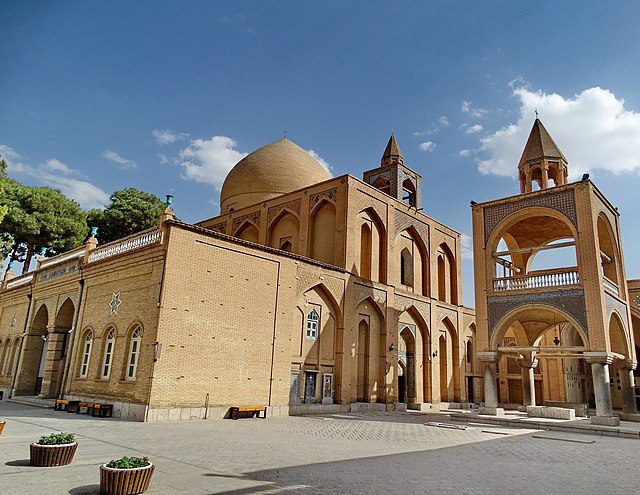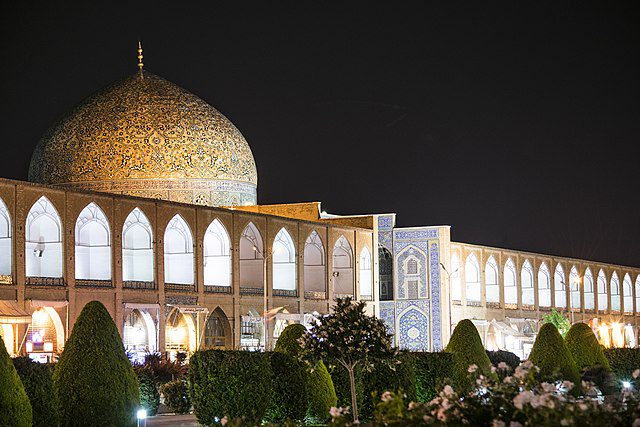Table of Contents
Isfahan, an old city in Iran, is full of old stuff that’s really important. There are lots of old things here, like buildings and stuff, that are so special they’re on Iran’s super important list. Imagine, this city used to be the main place where the big bosses ruled Iran at different times! People, especially the kings, really liked this place. Now, when you walk around, you’re basically taking a trip back in time.
Isfahan has cool old palaces and buildings that tell stories of way, way back. It’s like a big history book but made of stones and walls. Explore Isfahan, and you’ll see how it’s like a time machine, showing you what life was like a super long time ago. Here is the list of top tourist attractions in Isfahan:
1. Naqsh-e Jahan Square

At the heart of Isfahan sits the captivating Naqsh-e Jahan Square, an Iranian UNESCO World Heritage site, alternatively known as Shah Square or Imam Square. Picture a vast, rectangular expanse, not just for appearances but a versatile hub, stretching 160 meters wide and 560 meters long.
Crafted by the Safavid dynasty in 1598, this square is no ordinary space. Surrounding it are key historical players like the Abbasi Congregational Mosque (Shah’s Mosque), the Lotfollah Mosque, Ali Qapu Palace, and the Imperial Bazaar, featuring the renowned Qeysarie Gate. Here, history unfolds in architectural tales, each building contributing to a grand narrative of Safavid opulence.
2. Khaju Bridge
Standing gracefully on the eastern side of the Zayandehroud River, Khaju Bridge is a masterpiece with 24 elegant arches, a companion to the Si-o-Se Pol bridge. Legend has it that this bridge, with a history reaching back to 1650 during Shah Abbas II’s rule, is more than just stone and mortar—it’s a portal to the past. Stretching 133 meters in length and 12 meters in width, Khaju Bridge isn’t just a walkway; it’s a journey through time. In its midst lies a unique building, once a temporary haven for the Safavid Shah and his kin. Marvel at the intricate beauty of its architecture and tiling, a testament to the craftsmanship of bygone eras.
Venture to the eastern corners, and you’ll encounter two stone lions, proud symbols of the Bakhtiari troops, the stalwart guardians of Isfahan and the Zayandehroud. As you stroll across Khaju Bridge, one of the best tourist attractions in Isfahan, feel the whispers of centuries past and immerse yourself in the stories etched into its arches and the folklore embodied by those stone guardians.
3. Si-O-Se Pol Bridge
Also called the Allahwardi Khan Bridge, Si-O-Se Pol spans the Zainderud River with its 33 arches. It was put together in 1600 when Shah Abbas Safavi was in charge. Back then, this bridge did more than just connect places – it was a spot for the water-sprinkling event and a meeting place for Armenian pilgrims. Stretching 295 meters long and 14 meters wide, this bridge is more than just a structure; it’s a showcase of Iranian and Safavid building skills. Picture it like one of the most amazing bridges globally, telling stories of the past with each step you take.

As you walk across Si-O-Se Pol, imagine the old ceremonies and pilgrims, and feel the history built into its stones. As one of the top tourist attractions in Isfahan, it is a doorway to a time when buildings were not just practical but told stories of cultures and traditions.
4. Ali Qapu Palace

Isfahan tourist attractions are more to mention! In the middle of Naqsh-e Jahan Square, you’ve got this cool place called Ali Qapu Palace. It’s one of Isfahan’s nicest spots, and you should definitely check it out. From the very top floor, you get this awesome view of the square. But here’s the really neat part – inside, there’s this special music room. Back in the day, musicians would play Persian instruments, and the music echoed all around the palace. It was like a grand concert in a fancy room!
Just a heads up, though – if you want to explore all six floors, get ready for a little climb. There’s this narrow, twirly staircase connecting everything. Don’t worry, it’s worth it. Each floor has its own story to tell, and you’ll feel like you’re stepping back in time. So, take a climb, and let Ali Qapu Palace show you its mix of pretty sights and cool tunes.
5. Chehel Sotoun

Chehel Sotoun Garden is one of the top Isfahan places to visit that everyone knows about. It took a long time to build because it’s a huge 67 thousand square meters! Found in Imam Hossein Square on Ostandari Street, this place used to be called Jahannama Garden.
Now, the Chehel Sotoun Palace, with its twenty columns, is pretty special. The name, “Forty Columns,” comes from their reflection in the nearby pond. Some say it used to have forty columns, but a fire in 1707 left only twenty. Inside, you’ll see cool stuff like mirror works, big wall paintings, and wooden columns. The doors and windows are super fancy, showing off real Iranian art. Back in the day, important people met in the big hall here.
6. Vank Cathedral

In Isfahan’s Jolfa neighborhood, you’ll find Vank Cathedral, also called Amna Perkich Church. It’s one of Isfahan tourist attractions and also the old Armenian churches in the city, built on a big 8,731-square-meter area when Shah Abbas II was in charge. The church building itself is about 3,857 square meters, and the rest is a cool garden. The church has a tall bell tower with a clock on the second floor that weighs a whopping 300 kg. And get this – the dome of the church looks like the domes on Iranian mosques from back in the day.
Inside, the walls, arches, and the big dome are covered in oil paintings. They used gold and fancy manuscripts to decorate the church, making it different from other Armenian churches. Walk around, and you’ll feel the stories of the Armenian community, like a colorful history book coming to life.
7. Sheikh Lotfollah Mosque

Right across from Aali Qapu Palace in Naqsh-e Jahan Square, you’ll find the beautiful Sheikh Lotfollah Mosque. Here’s the cool thing about Isfahan – lots of the Isfahan places to visit are super close to each other, making it easy to explore!
Now, the mosque itself is like a work of art. It’s not surprising that it’s one of the top attractions in Isfahan. The dome of the mosque is something else, and the blueish tiles make it even more awesome. When sunlight sneaks in through the windows, it turns into this magical play of colors that will leave you in awe.
8. Jameh Mosque of Isfahan

One of the top tourist attractions in Isfahan, the Jameh Mosque is a living testament to Iran’s religious and architectural history. Among the oldest religious complexes in the country, its roots dig deep into the past. While the Seljuk period shaped much of its current appearance, the mosque’s evolution continued through later eras, especially the Safavid era. Delving into the soil around it has unearthed treasures from pre-Islamic times, adding layers to its historical narrative.
Locally known as Jame Atiq Mosque, this treasure is tucked away in the old heart of Isfahan, found in Qiyam Square, along Allameh Majlesi Street, at the west end of Hatef Street, and marking the conclusion of the Grand Bazaar. While Naqsh-e Jahan Square whispers Safavid tales through its architecture, the Jameh Mosque, and its surroundings spin a legend of life during the Seljuk era and even earlier. It’s not just a mosque; it’s a living history book, each corner holding secrets of times long gone.
9. Imam Mosque (Masjed-e Shah)

Among Isfahan tourist attractions, the Imam Mosque is a must-see, easily standing out as one of the city’s most recognizable attractions. It’s the kind of place you shouldn’t miss when exploring Isfahan. Featuring a grand entrance, two striking minarets, and the main mosque building, this magnificent structure is a visual delight.
Step inside, and you’ll find yourself surrounded by an awe-inspiring display of blue tilework, turning every nook and cranny into a breathtaking masterpiece. The mosque is quite expansive, so we recommend dedicating at least an hour to fully appreciate its grandeur. It’s not just a mosque; it’s an experience that unfolds with every step, offering a glimpse into the rich cultural and architectural heritage of Isfahan.
10. Isfahan Music Museum

One of the Isfahan places to visit is its Music Museum. You’ll find the Isfahan Music Museum on the famous Cheharbagh Abbasi Street, right by the lovely Hasht Behesht Palace. Guess what? It’s the first-ever private music museum in Iran.
So, a “music museum” is like a home for all sorts of musical instruments. But this one is extra special because it shows off the cool music history of the country. At the Isfahan Music Museum, there are more than 300 types of musical instruments waiting for you to check out. And it’s not just about looking – there are live music shows too! People who really know their stuff will be there to chat with you, explain things, and answer all your questions. It’s like a fun journey through Iran’s musical past.
FAQs about Isfahan Attractions
Q1: What is Isfahan known for?
A1: Isfahan is well-known for its beautiful Islamic-style buildings, wide streets, arched bridges, royal homes, decorated mosques, and tall towers. It also has lots of old buildings, landmarks, paintings, and ancient items. Isfahan is so famous that there’s a saying in Persian: “Esfahān nesf-e-jahān ast,” meaning Isfahan is like half of the world.
Q2: What makes Isfahan special?
A2: While traveling through its mosques and Islamic buildings, Isfahan is called the City of Turquoise Domes. Naqsh-e Jahan Square is bordered by Jame Abbasi Mosque, Lotfollah Mosque, and Ali-Qapu Palace. Each of these places is so beautiful that it would take hours to capture their magnificence in words.
Q3: Is Isfahan a beautiful city?
A3: Many tourists think Isfahan is the prettiest city in Iran and among the most beautiful globally. It boasts many tree-lined streets, colorful flower gardens, extensive parks along the Zayandeh Rood River, ancient covered markets that are 1300 years old, as well as bridges, palaces, mosques, and tall towers.
Q4: Why visit Isfahan?
A4: Isfahan, often called “Half the World,” is more than just a city with stunning mosques, old bridges, and peaceful gardens. It’s also a center for traditional Iranian arts and crafts.
Q5: What is a fun fact about Isfahan?
A5: Isfahan is the third-largest city in Iran and ranks as the third most populous after Tehran and Mashhad. It boasts six UNESCO-recognized heritage sites. Known as “Nesf-e Jahan,” meaning half of the world, it earned this title due to its splendid Islamic architecture, attractive boulevards, historic bridges, palaces, and mosques.
Last Words: Experience the Beauty of Isfahan Attractions with a Customized Tour
Isfahan, an ancient city in Iran, is filled with important old things like special buildings that are on Iran’s important list. It used to be where big bosses ruled Iran, and people, especially kings, loved it. Now, walking around Isfahan is like going back in time. It has cool old palaces and buildings that are like a history book made of stones.
To truly savor the essence of Isfahan attractions, it’s advisable to consider Customized tours that cater to your specific preferences and interests. One such facilitator of personalized experiences is To Iran Tour, dedicated to crafting unforgettable memories for travelers seeking to explore the wonders of Iran.
From the majestic Naqsh-e Jahan Square to the awe-inspiring Imam Mosque, every step of your journey is tailored to maximize your enjoyment. With To Iran Tour, your journey through Isfahan becomes more than a trip!

